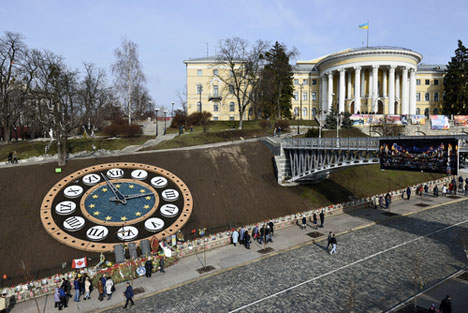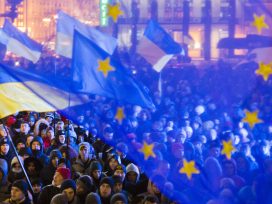The Maidan protests have given Ukraine a chance to stop and look at its future, and plan it the way she wanted to, writes Kateryna Botanova. Now it’s becoming apparent how to make the revolutionary shift from continual fighting, distrust and questioning of legitimacy to mutual support, collaboration and growth.
The time is out of joint; O cursed spite
That ever I was born to set it right!
Hamlet, Act 1, Scene 5
“The time is out of joint”: Hamlet’s lament is an apt description of Ukrainian history since 1991. Like characters out of Serhii Zhadan’s novels, the country was living in the past and pretending not to notice. Crumbling roads, cold old apartment blocks, dusty yards and abandoned parks where people live, lost in time, and yet still full of hopes and expectations. Their hopes are not very well articulated and their expectations are not too high, so there is no disillusionment per se. By the end of the story, the reader is rocked by the “normality” of their life, coming out of nothing and going nowhere. There is no flying high or falling low. It’s like the title of what is probably Zhadan’s most famous book, Voroshylovgrad. To Ukrainian readers, this sounds like a generic name for a little provincial town in the middle of nowhere, bearing the distinct mark of a Soviet past (although in reality this is just an old Soviet name for the city of Luhansk – once a large industrial centre in eastern Ukraine, now in the occupied territories). For foreign readers, it is an almost unpronounceable string of letters, so in translation the book is known as “The Invention of Jazz in Donbas” – sexy, but so far from the original.

“There are no ready-made answers anywhere, and time is not something that can be set right”, says Kateryna Botanova. Pictured above, the scene before the “October Palace” in March 2016, with various commemorative gestures to coincide with the second anniversary of the Maidan protests. The October Palace was among the buildings occupied during the Maidan. Photo: shutfotofield/Shutterstock.com. Source: Shutterstock
So far, it is the typical story of a post-Soviet country, maybe with a bit more charm and a southern vibe, maybe a bit more promising, but somehow constantly failing.
From a distance of two years, Maidan (or Euromaidan, the mass civic uprising of 2013-14 against the increasingly corrupt and authoritarian regime of president Viktor Yanukovych), whatever other importance it had, looks like an attempt to re-set the dislocated joint, to fix the country’s history, to put it back on track. Much as any revolution, it embodied a break in time, a rupture between a present that looked and functioned very much like the past and into which people no longer fit, and a post-present, which for three months was literally constructed with bare hands and where all those hopes, desires, dreams and expectations that had been so long abandoned or suppressed were placed. Like most of the contemporary velvet revolutions, Maidan was driven by a belief in the existence of a true and proper flow of time that the country needed to get back to or, rather, to catch up with.
Ever since, public intellectual and political discourses of Ukraine’s most recent history have been divided into two parts. Maidan has become a sort of magical sign of irreversible changes, of the start of a new country – a country, as it was often said, that had constantly been failing since 1991. Now history could start from a blank slate, as if the past no longer had any power and as if mere intentions were enough to change a poor, corrupt country with a failing economy into a prosperous, just and trusting society with an efficient government and a responsible business sector. Maidan became a phenomenon in and of itself, an idea of perfect and powerful changes, a state of mind, beyond the actual protests and subsequent political developments, including the war.
The phenomenon of Maidan existed beyond the time that it was supposedly setting right, outside of history itself. It developed its own inner mythology: its fighters, its legends, its ideals and beliefs, and its martyrs. This ahistorical nature of Maidan helped to save and preserve its ideals, and in public discourse it became the ultimate measuring stick – ethical, professional, political – for all changes and reforms, those that had been attempted or those that seemed possible. Now civil society (which had been almost non-existent in the country prior to Maidan) demands that any step – from fixing up a city park to constitutional reform – conforms to European values, which Maidan has metaphorically emblazoned on its flag: justice, the rule of law, trust, social and civic responsibility, transparency. A recent sociological survey shows that although trust in the state as represented by the parliament, the president and the government is declining, the belief that civil society is getting stronger and more active continues to grow.
But what the symbolic nature of Maidan could not break was the institutional and legal continuity. The legal code, and the legal sphere in general, were still rooted in the past. The legal system was resilient enough to absorb most civil society activities and the majority of those people who newly dared to become a part of it, hoping to change it from within. The intense bottom-up movements and escalating politicization of civil society actors, originating from and empowered by Maidan, soon faced clear limits to their power, as well as problems stemming from their horizontal organizational structures. Active and persistent efforts to advocate and lobby for changes in various spheres once again bumped into the rigidness and resilience of the system. That came as a surprise. Society, demanding the swift implementation of necessary changes, faced a state that it neither trusted, nor understood the logic behind. The juridical illiteracy of the majority of activists and society in general has run into a governing system so twisted, illogical and complex that frustration was inevitable. (Recently, a deputy head of the presidential administration and former director of Microsoft Ukraine mentioned in an interview that any serious reform requires a careful and lengthy “untying of the knots” of legal complexities that were created during the course of 23 years to ease corruption.) It was presumed, in a way, that the magic of Maidan would make changes easy and radical, but it did not. Maidan showed its own complex nature: it was, on the one hand, necessary fuel for civic activities but, on the other, it served as an obstacle, obscuring the continuities of a system that required change, and impeding a longer perspective on the efforts needed to reach the set goals of great reforms. Magic does not need time, right?
Frustration manifested itself quickly in radical demands – to get rid of certain ministries, or certain ministers, or governmental agencies; or to lower the number of MPs; or to quickly elect yet another president. One of the most systemic, vociferous, public and constant demands was for the ministry of culture to be dismantled.
***
The cultural sphere in Ukraine has not been reformed since 1991, despite some attempts having been made in recent years. There has never been a good time for it, nor sufficient political will or pressure from civil society. The system of cultural governance successfully ignored the independent sector. And though independent actors have managed to stay active and dynamic over the years, they did not see the state as a partner important and powerful enough to fight for.
Thus two parallel cultures co-existed – official and non-official or independent, a division preserved from Soviet times, where ideology and freedom were the dividing lines between the two. The Ukrainian state tried to use culture as an ideological tool a few times, but with no particular success, as ideology required consistency and persistence, something local policies – especially cultural ones – always lacked. So after independence the dividing line was mostly change and innovation: the official culture was rigid, stiff, boring and out-dated, while the independent one was (or attempted to be) innovative, experimental and European, trying to reconstruct the context and renew the connection to the broader European cultural world it had lost under the Soviet rule.
For years the two cultures – official and informal – successfully ignored each other, and the gap between them deepened with every passing year. If there was any cultural policy before Maidan, this was it. State culture, following its Soviet blueprint, predominantly continued to produce passive people, who slotted into a hierarchical system and were afraid of any original move. Independent culture was run by volunteers with little money, little support, boundless energy and a strong belief that “it has to work out, somehow”.
Maidan in particular was a manifestation of both the desperation and the strength of these cultural volunteers, fighting against the rigid system, making themselves finally seen and heard by the deaf and ignorant state, taking power into their hands. They went there not as artists, or managers, or intellectuals, but simply as people, citizens of the country they wanted to live in. To the often posed question: “What did art do for Maidan?”, there is a good answer: it was Maidan that did a lot for art. It provided a way out of the “ghetto” of a parallel, underground culture (or even the cultural “ghetto” in general, turned inwards for survival and self-assurance) and to assert the right to be citizens, to lay claim to power and initiate change.
***
In the post-Maidan reality this potential has taken several forms. A number of new, mostly non-institutionalized platforms, initiatives and groups were formed around the country, to work towards and advocate for changes. The Assembly of Cultural Workers originated from an “Occupy the ministry of culture” movement that started in the very first days after Maidan. A very diverse group of activists occupied the ministry’s basement for several months, discussing the needs of cultural workers and possible ways to reform cultural policy. Their main message was that the ministry of culture in its present form must be gotten rid of. The Assembly slowly dissolved due to internal conflicts, but the message persisted, spreading through social and mainstream media and becoming one of the most popular post-Maidan memes. Two other initiatives were inspired by the Assembly: the Congress of Cultural Activists (later institutionalized), a vast network of activists all over the country, aimed at strengthening local cultural initiatives, networking, mutual support and advocacy for changes; and a cultural group at the Reanimation Package of Reforms organization, which began as a volunteer think tank platform but was quickly institutionalized, specializing in facilitating discussion and lobbying for legislative reforms in all fields.
Yet another group that also appeared as a volunteer platform during the last days of Maidan was the Platform for Strategic Initiatives Culture-2025. Culture-2025 stated the need to develop a comprehensive and inclusive long-term strategy for culture. Experts who were part of the platform held a series of focus groups and discussions in eight cities and ten cultural sectors, insisting on the fact that an inclusive strategy starts with an inclusive approach. This platform came under severe criticism from the government and part of the cultural community for concentrating on developing a strategy for ten years down the line, at a time when swift measures needed sooner rather than later. At the same time, however, no concrete measures other than shutting down the ministry of culture could unite activists.
Some of the important findings of Culture-2025 were presented in five so-called “non-intervention scenarios”. These are possible future scenarios based on forecasts of developments in the cultural sphere if state policy, mostly conceived and enacted by the relevant ministry, does not change. The scenarios clearly illustrate the fact that the system of state governance is not just a continuation of the pre-Maidan system, but that its roots stretch deep into the Soviet era. Being aware of this continuity is a necessary precondition for serious change, which may be inspired by Maidan but should not be blinded by it.
The first scenario, “investment in stagnation”, shows that by investing the little money it has for culture into out-dated and profoundly provincial institutions and initiatives, the state basically puts all its effort, resources and power into stopping whatever change and development may otherwise be possible. Held back by inertia, the state manages only the assets that it owns, ignoring all other spheres where actual development and innovation happen: the independent scene, business and civil society in general. Instead of supporting and empowering change, the state replicates the old model, deepening the gap between itself and civil society.
“Jump into the past”, the second scenario, demonstrates how the state preserves an elitist and exclusivist approach to culture, which can be seen through its management of cultural infrastructure (theatres, museums, concert halls, etc.). The greatest part of the infrastructure is left over from Soviet times, in major need of reconstruction or simply repair. While in most cases it belongs to local communities, local self-government still acts and is perceived as “the state”, being an important and generally obedient part of a larger hierarchical system. Cultural infrastructure is predominantly concentrated in the big cities and in the city centres. Accessing it requires effort, and there are no plans for new infrastructure. This situation creates a perception of culture as something irrelevant, unpopular and unnecessary.
“Legitimacy gap” is the third scenario, one consequence of which is a huge lack of trust between state agencies and civil society. The agencies are increasingly seen as illegitimate, because they don’t respond to current challenges and reject change. The illegitimacy of state agencies makes any future reformative steps on their side extremely difficult, if not completely impossible, given that any trust that might once have existed is simply no longer there. Moreover, the legitimacy gap also means a lack of trust among civil society actors. Exhausting cultural volunteering, a severe lack of resources and seeing little prospect of finding a place for the desired changes in the political agenda provokes a “zero sum game” among civil society actors.
“Manipulation scenario” implies that due to an out-dated education system and methods, the cultural network is not integrated into the education curriculum. The very low position of culture on the public agenda results in very low civic competencies, poor critical thinking skills and short planning horizons on the side of civil society. As a result, society is easily manipulated, susceptible to propaganda and inclined to populism and paternalism. Unfortunately, this is relevant not only to the past, but also for the future.
The last scenario, “culture of hunting and gathering”, demonstrates how, for years, culture has been perceived as a sort of natural phenomenon that does not require support or investment and which is taken to be a luxury, not a necessity. Failing to see culture as a vital part of sustainable development results in narrowing it down to leisure activities and “high art”, disconnected from and not understood by the masses. Thus, the whole visionary and humanistic potential of culture is not recognized.
***
Despite the manifold efforts that have gone into analysis, activism and advocacy, two years after Maidan reforms are still out of reach and, since no radical intervention has been made, these scenarios have taken full effect.
This brings up the paradox of the ministry of culture, the main governmental agency responsible for the development and implementation of cultural policy. In the last two years, the ministry has become a favourite social media meme as a symbol of incompetency, opacity and personal preferentialism. In the best traditions of the Soviet past, the ministry of culture sends artists to perform for the military in the war zone to “bolster their spirits”, demanding that the country’s regions and cities become cultural patrons of towns and villages in eastern Ukraine, drawing them into “Ukrainian culture”, and imposing embargoes on Russian cultural products (films, TV series, or books) and artists.
Here, paternalistic attitudes are combined with a conservative nationalistic rhetoric and lack of managerial competency, all of which coincides with the manipulation of Maidan ideas. The ministry itself embodies the dilemma of doing vs thinking, present in a variety of fields where reforms are sorely needed. This is about tactics vs strategy, about believing in windows of opportunity that open for a short time and have to be taken advantage of, regardless of the price. In the end, it is about believing that there is a proper time and a way to “set it right”, to catch up. Thus, instead of reassessing needs and current problems and matching them against the vision of the country in wider perspective – in one or two decades, after the war, after the conflicts – governmental agencies operate on the basis of situational micromanagement.
The problem of “setting time right”, of putting it on the right track is that it implies the flawlessness of steps and decisions taken. If there is one correct flow of time, and let’s call it a European one, all possible measures and decisions already exist within it, so all that needed to be done was to adopt them.
It seems that activists are behaving in much the same way nowadays. A large number of volunteer or semi-volunteer initiatives that sprang up after Maidan, in addition to the substantial number that existed prior to it, have stepped in to fill cultural voids. There are numerous creative hubs and co-working communities that organize artistic, educational and social events; new public media outlets are emerging, large and small, opening in different cities and towns; crowdfunding campaigns are underway for cultural projects in areas close to the war zone; clubs are letting in new experimental theatre groups and temporary exhibitions; activist groups are fighting to protect cultural heritage against “decommunization” or business interests (sometimes the two go together). It was thanks to volunteers – professionals receiving little or no pay – that, for example, a Ukrainian pavilion was present at the Frankfurt Book Fair, or post-Maidan exhibitions travelled through Europe, or children from the war zones took part in art therapy and various creative activities.
***
These initiatives are interesting and innovative, but the problem is they do not add up to systemic change. Civic activity is failing to rise to a political level for two reasons: on the one hand, there is intense resistance from the system, but on the other, activists believe that neither their time nor their trust is worth investing in working toward greater change.
Is it too much to assume that one of the reasons for Ukrainian isolationism, for being so concerned with and concentrated upon internal issues and problems, is that the lack of perspective and inability to articulate a long-term vision for the future keep society as a whole occupied with everyday steps that are both so necessary and so small? It is like having to think about breathing with every breath – good for meditating, but impossible for life more generally.
Surveys show that Ukrainians trust individuals much more than they trust institutions, and that astrologists carry significantly more weight than politicians. Wouldn’t the belief that politics is crucially important for sustainable change – even if it might sometimes mean more work and be less certain than astrology – be another necessary inner Maidan, finally opening up fertile ground for the ideas and ideals of the one that happened two years ago?
The long-term strategy developed by Culture-2025 is based on the notion of “open access”, promoted in Ukraine by another volunteer group of intellectuals working on a long term vision for the country, the Nestor Group. Open access implies free, just and unrestricted access to decision-making and resources for all citizens, not just those in power. This is an important shift in the perception and handling of power, when the state ceases to be an enemy, an obstacle or a thief and becomes an important and necessary tool for change. Sustainable development, enabled by an open access model, positions culture as a vital element. This is a means of life-long education, fostering crucial civic competencies and critical thinking skills. It is an inclusive space that empowers and gives people a voice, which is especially urgent in Europe nowadays. Culture is an important space for imagining future models of individual and social life, and testing them safely. And, of course, as a source of creativity and innovation, it is an invaluable contributor to the economy.
Thus, a reassessment of the sense and potential of both culture as an enabling environment and the state as a tool opens new horizons for cultural activists, as well as for society in general. Open access can finally close the gap between official and non-official culture, making this division history. Open and equal access to resources and decision-making can strengthen cultural institutions, finally shifting the burden of educational and developmental activities from volunteer groups to more stable and sustainable entities. Changing the governing model from managing to enabling and creating possibilities, or as it was termed in one international assessment “from the ministry of culture to the ministry for culture”, has the potential to make a revolutionary shift from continual fighting, distrust and questioning of legitimacy to mutual support, collaboration and growth.
Paradoxically, volunteer movements can block the development of cultural politics if their plurality of tactics does not coalesce into a clear strategy. Two years in, Maidan has done its magic: it preserved the European values of the supremacy of justice and human rights through the very tough times that always come after revolutionary fervour and upheaval. It fuelled numerous activists and ordinary people, who had never even seen themselves as activists, in starting to shake ground that had never been shaken before. It inspired an almost religious belief that the changes made would be irreversible, however small they might seem, that the country would never fall back into “timelessness”. Now is a good time to rethink what Maidan means to society, to keep being inspired, rather than blocked.
There are no easy answers awaiting Ukraine in Europe, which as the current crisis shows may well be founded far less on shared values than might seem to be the case from the outside. There are no ready-made answers anywhere, and time is not something that can be set right. The most that can be done is to stop it from going round in a vicious circle. The magic of Maidan was that, as in an ancient ritual, it could stop time just to break the circle, to transform people from a mute mass to a distinct political subject. Maidan has given Ukraine a chance to stop and look at its future, and plan it the way she wanted to. If there were ever a window of opportunity that needed to be taken, this is it. Moreover, the past two years, made up of hundreds of small steps and experiences, have given us enough experience to begin turning all of this into a strategy. And if peace, inclusiveness and development are on the agenda, there is no better sphere to draw from than culture. All that is needed is to be able to look back clearly in order to see the future.
Published 10 March 2016
Original in English
First published by Eurozine
Contributed by Transit © Kateryna Botanova / IWM / Eurozine
PDF/PRINTPublished in
In collaboration with
In focal points
Newsletter
Subscribe to know what’s worth thinking about.
Related Articles

House keys recur in the stories of Crimean Tatars and Palestinians displaced from their respective homelands in the 1940s, and Ukrainian citizens fleeing Russian invasion since 2014. Ethnographic research and discourses on art and justice show how objects emblematic of home salvage the history of exiled peoples from oblivion.

As capital consolidates, culture recedes, funding vanishes, access narrows. The question persists: why fund culture at all? Cultural managers from Austria, Hungary and Serbia discuss.






